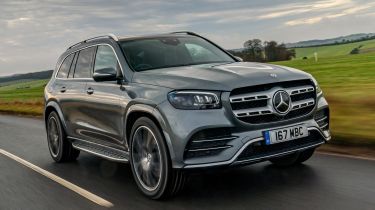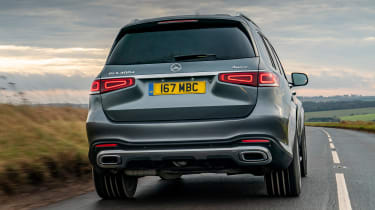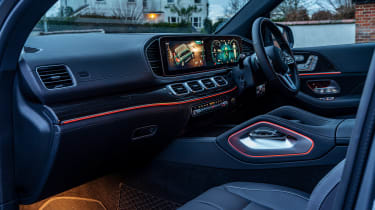New Mercedes GLS 2019 review
The new third-generation Mercedes GLS has arrived to take the luxury SUV fight to the Range Rover and BMW X7

The new Mercedes GLS is an enormous SUV and represents an enormous improvement on the previous model. But Merc’s self-appointed strap line of ‘the S-Class of SUVs’ is little more than the marketing department in overdrive. While the brand’s flagship limo is well established as the best in the business, the GLS doesn’t arrive in Britain with any real edge over its rivals to make it stand out as the definitive choice in this class.
At over 5.2 metres long, 1.8 metres tall and 2.1 metres wide, few new cars you’ll see on British roads in 2020 will be larger than the new Mercedes GLS. It’s back for a third-generation, and here to take on the latest incarnation of the Range Rover and the all-new BMW X7, too.
Cars this big don’t make much sense in the UK, and for Mercedes SUV buyers after space and height, the brand’s latest GLE is surely more than enough to satisfy. Yet the evergreen popularity of the Range Rover proves that there are plenty of people who want something of this size.
In that regard, the GLS certainly doesn’t disappoint. It’s actually larger than both the Range Rover and the X7, with a wheelbase 60mm longer than before for even more interior space. Three rows and seven seats occupy the cabin, while the boot sizes up at 470 litres with the rearmost chairs in place. Fold everything nearly flat – done electrically of course – and you’ll be presented with a vast 2,400-litre loading bay.
Elsewhere you’ll find the GLS lifts its dashboard and centre console from the GLE, and to look at at least, this flagship SUV’s cabin is very similar in appearance to its smaller sibling. However, the design is trimmed with some plusher materials and veneers as standard – much like how BMW differentiates the X5 from the X7.
Used - available now
The head-up display is huge and useful, while Infotainment is solid in presentation, too. Though while the dual 12.3-inch screens up front are bright and beautiful, the MBUX software running on them is still a little unintuitive to browse. It’s a better and more impressive set-up than what you’ll find in a Range Rover, but BMW’s iDrive system remains the best in this class.
If the design is a little familiar, the luxurious toys and kit stacked on top of the borrowed interior architecture do their bit to lift the environment. The entry level, £75,000 AMG Line Premium model still relies on Merc’s ARTICO man-made leather and brushed aluminium on the dashboard and doors, however, and most of the luxuries are saved for the driver and passenger up front.
Flagship models like the AMG Line Premium Plus Executive car we tried expand the experience across all three rows though. All seats are heated, there’s a widened centre armrest hiding a tablet computer in the middle row, softer headrests, gloss wooden trim, and Nappa leather is standard, too. There’s still a definite whiff the smaller of GLE, but it goes some way in helping the GLS feel like a car commanding a £90,000 price tag.
The various massage functions up and down the cabin and the addition of sunblinds on the rear side windows further lift the premium edge. Rear seat entertainment screens 11.6-inches in size are found in the back, but a six-seat layout with two full size rear seats – as optional on the BMW X7 – isn’t offered on the GLS in the UK.
Get on the move and you’ll immediately gel with the engine. The 3.0-litre six-cylinder 400d is the only powertrain offered from launch, but it’s probably all the engine you’ll need in the GLS. Performance is strong considering that this is such a big and heavy car, with the 700Nm of torque the defining factor. It pulls the mighty GLS along very well if you lean on the throttle, and with little fuss; it’s silky smooth, serene and the nine-speed transmission is a worthy companion.
Merc says you’ll do between 28 and 32mpg depending on specification, so it’s not hugely economical, but in the context of what the GLS is and who will buy it, those are numbers that will surely suffice.
When we drove the GLS in the US earlier in the year we commented on the ride quality with optional E-Active Body control suspension, which rolls the entire car against the demands of G-force to keep it flat during cornering. It also uses cameras to read the road surface and prepare the dampers for the worst, but sadly, it’s not a feature that’ll be offered in the UK. Here, every GLS get standard air suspension with adaptive damping.
It’s perhaps the major fly in the Merc’s ointment, as on UK roads the sheer mass (2,490kg) means that the GLS doesn’t take that well to our scarred tarmac. It’s not partial to thudding over the worst pockmarks and lumps, with the air suspension fighting back against them, instead, it’s the movement and jiggles that undo the experience a little. Sometimes, it feels more comfortable to firm the suspension up in Sport mode, reducing the swaying and keeping the Merc’s massive frame more upright.
Try a smaller, less ‘luxurious’ GLE on the same air set-up, and you’ll find it not just better to drive than the brand’s flagship SUV, but possibly more comfortable, too. For the ‘S-Class of SUVs’, that’s not a feather in its cap.
One thing that’s very S-Class about the GLS is the level of tech, though – that can’t be disputed. Virtually every piece of driver assistance technology the firm has developed is standard on the AMG Line Premium Plus Executive model, including Driving Assistant Plus with active lane keeping, steering, braking and accelerating assistance.
The optional £1,495 off-road package introduces a series of off-road driving modes, as well as fully variable all-wheel-drive with locking differentials, low range gears and hill descent control. Off-road features like this are not available on the BMW, though, of course, they’re one of the Range Rover’s biggest selling points.















